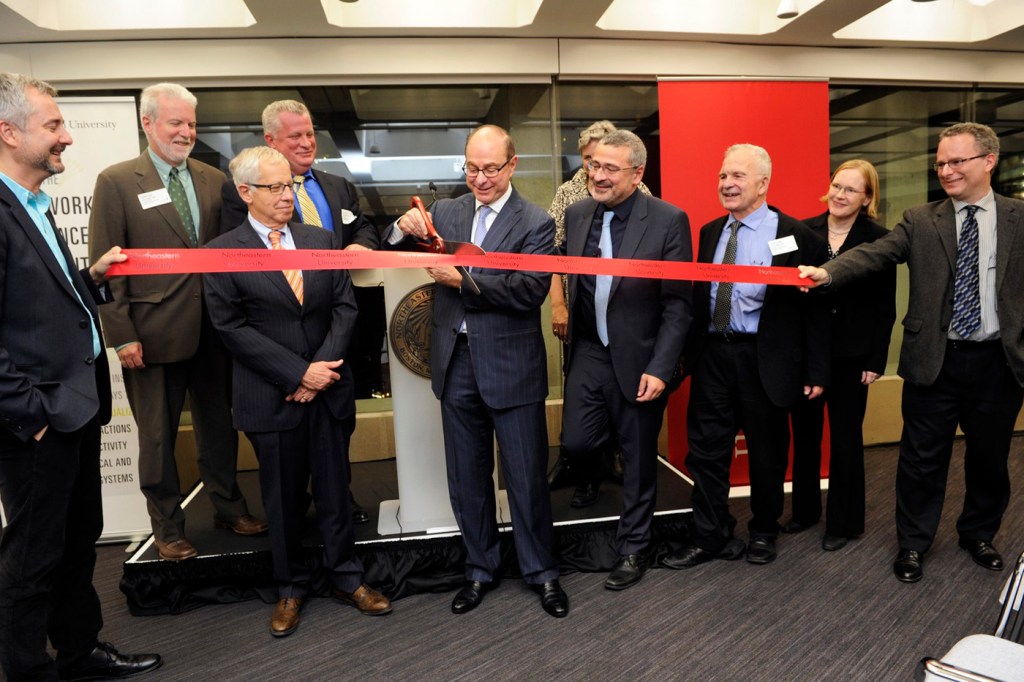World-renowned scholars launch Northeastern’s Network Science Institute

The mood was festive as President Joseph E. Aoun, network science luminaries, deans, students, and friends gathered on Wednesday evening on the 11th floor of 177 Huntington Ave. to celebrate the launch of Northeastern’s Network Science Institute, home of the nation’s first doctoral program in network science.
The Network Science Institute brings together an interdisciplinary team of renowned scholars from across the university to discover and inspire new ways to measure, model, and predict meaningful interactions in social, physical, biological, and technological systems. Its theme, “Solving Problems in an Interconnected World,” speaks to its commitment to develop intervention strategies that will improve the health and security of people around the world.
The “poster slam” following the ribbon-cutting ceremony displayed the breadth of research already underway. Topics included a quantification of the “science of success,” construction of a “Twitter barometer” of public opinion assessing issues such as the 2016 presidential race, and modeling the spread of the Ebola epidemic.
Addressing the enthusiastic crowd of more than 150 in the open glass-walled space were President Aoun; Alessandro Vespignani, the institute’s director and the Sternberg Family Distinguished University Professor; Albert-László Barabási, director of the Center for Complex Network Research and Distinguished University Professor of Physics; and Stephen W. Director, senior advisor to the president and former provost and senior vice president for academic affairs.
Here are some excerpts from their remarks:
Alessandro Vespignani
“When I think about the institute I think of a particle accelerator—those big monster machines for experiments in which you have particles that collide. And in the collision they destroy themselves but create new particles. I like to think that here we have a lot of ideas from different disciplines that collide and we create new science, new applications.”
Albert-László Barabási
“There has been a fundamental transition in the way we have understood how networks form over the past 20 years. Before network science came along, we thought the way you form a network is to get a bunch of people and randomly connect them—and something will come out of it. What network science discovered is that big successful networks form one node at a time. There’s always a first, there’s a second, there’s a third one—that is, growth is an essential property. That’s a feature of the network, and everything from the World Wide Web to the cell has gone through that particular growth process.
“I feel that’s exactly what happened at Northeastern. I came here eight years ago at the invitation of President Aoun. He and the administration of the university had a dream—they set us on the path of growing a network. We started adding nodes, one node at a time. We were doing what successful networks do. And the reason this was possible was that every new hire built on the excellence that the previous hires had made possible. Every year [in our unique doctoral program] we bring five to 10 new nodes, some of which will stay, some of which will take the buzz of networks to other institutions and let network thinking, which is the essence of the 21st century, grow further.”
President Joseph E. Aoun
“This institute was made possible by all the Northeastern deans, who from day one grabbed this opportunity and said, “We have to push for it.” Our deans have not only been excited but have built this. Now, when László said networks are built one node at a time, I completely agree with him. But from the beginning the network was already there as a vision. So we didn’t come to László and say, “OK, let’s build the first node, let’s build a second node.” The vision was not quantified based on the number of nodes but on the fact that from the beginning our goal was to build the best Network Science Institute in the world. And we’re only beginning—the future is in your hands. Don’t stop. The sky is the limit.”
Stephen W. Director
“I do know something about networks as an electrical engineer who is versed in circuits. I do know about graph theory. And nodes are important, but a network involves links. We have to be connected to one another. What makes this thing work is not just the nodes, because László and David [Lazer], and Alex could be nodes anywhere. What really makes it work are the links, the connections between them, and the connections between all the other nodes that are going to be generated. Congratulations. We expect great things.”









